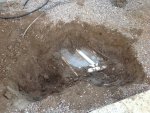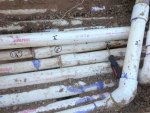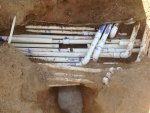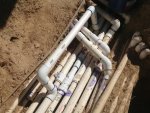- Aug 12, 2012
- 30
- Pool Size
- 30000
- Surface
- Plaster
- Chlorine
- Salt Water Generator
- SWG Type
- Pentair Intellichlor IC-40
I drove a 2’ rebar (stake) into the ground and right through a section of buried PVC - one of the lines that feeds an in-ground pop-up. After draining the pool below the line's water level, I dug up the area to repair the pipe -- HOWEVER, it's surrounded tightly by about 15 other pipes crisscrossing and about 2-3 feet on each side: other popups, water feature, drain, etc. It is impossible to get at, even if I could dig under the bundle it wouldn't help.
Will epoxy, something like http://www.aplusbputty.com/ be sufficient to patch the hole? I was able to put my finger over the hole and stop the leak so the pressure isn't tremendous.
The only other choice may be to dig 4-5 feet down, 10 feet wide and long and hope to be able to move the section enough to cut then couple/glue – highly doubtful. Also, bypassing this by laying a new section may not work either as the pipe elbows down among the mass to go down below the pool.
Will epoxy, something like http://www.aplusbputty.com/ be sufficient to patch the hole? I was able to put my finger over the hole and stop the leak so the pressure isn't tremendous.
The only other choice may be to dig 4-5 feet down, 10 feet wide and long and hope to be able to move the section enough to cut then couple/glue – highly doubtful. Also, bypassing this by laying a new section may not work either as the pipe elbows down among the mass to go down below the pool.





 ...
...
